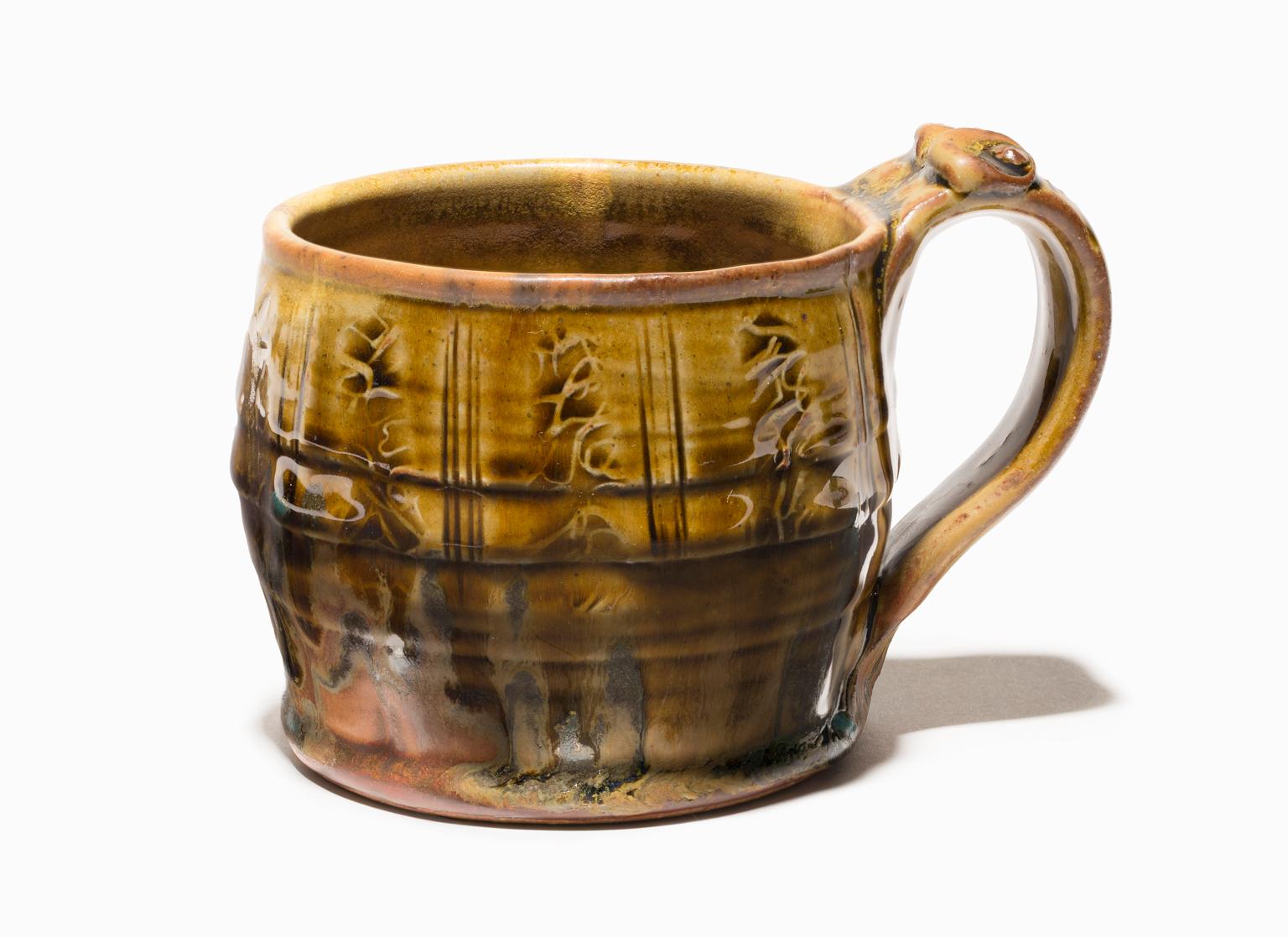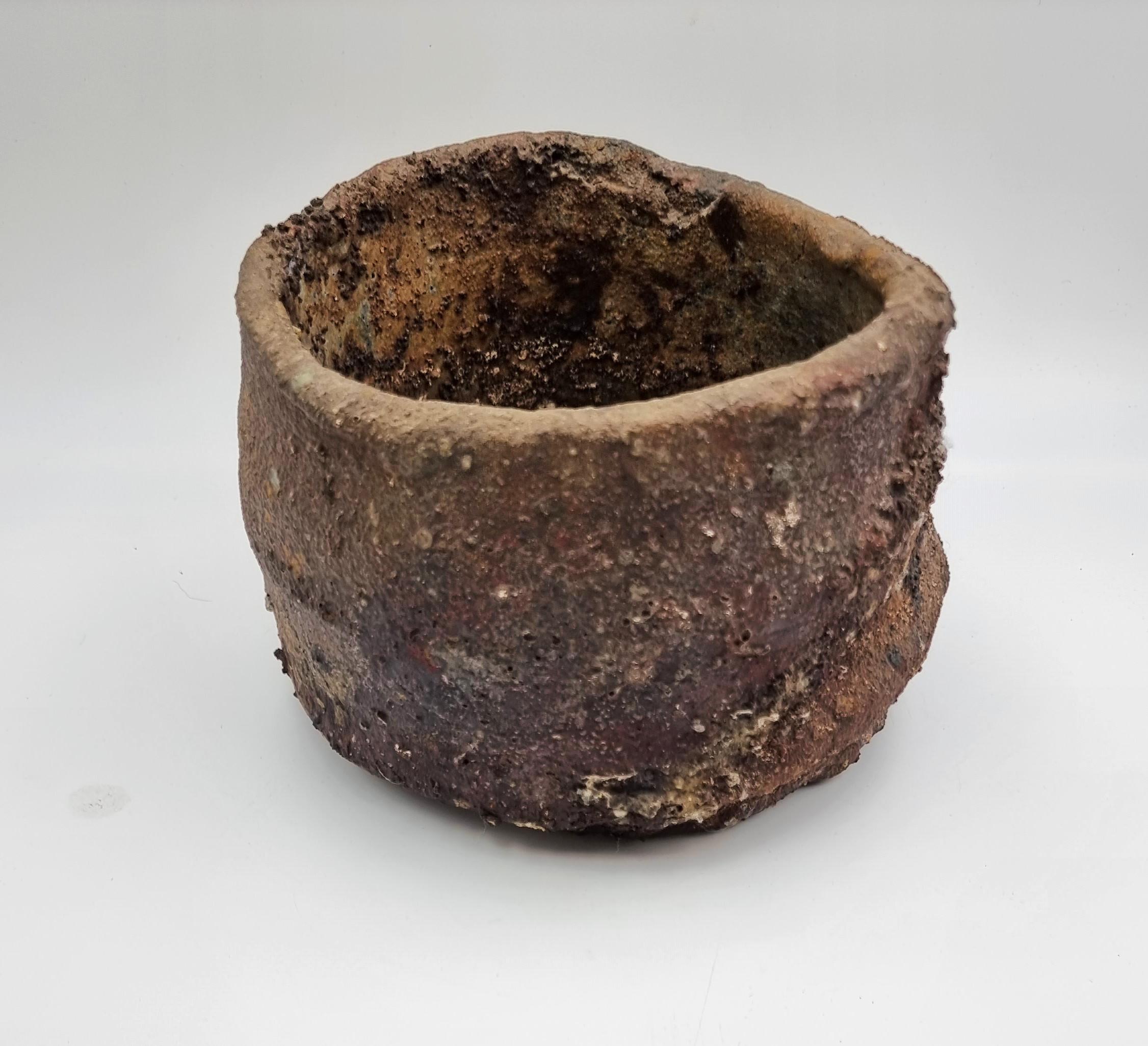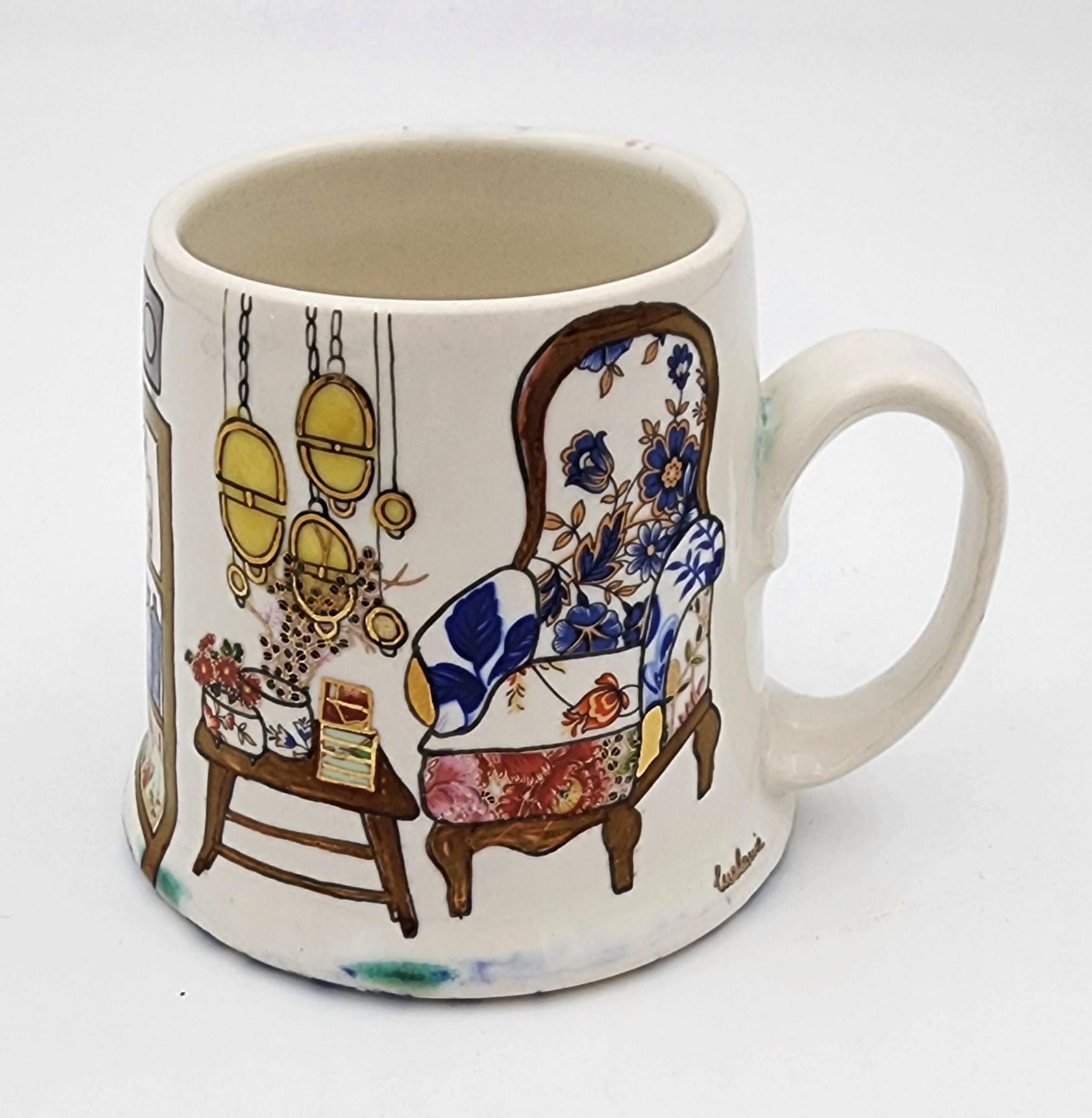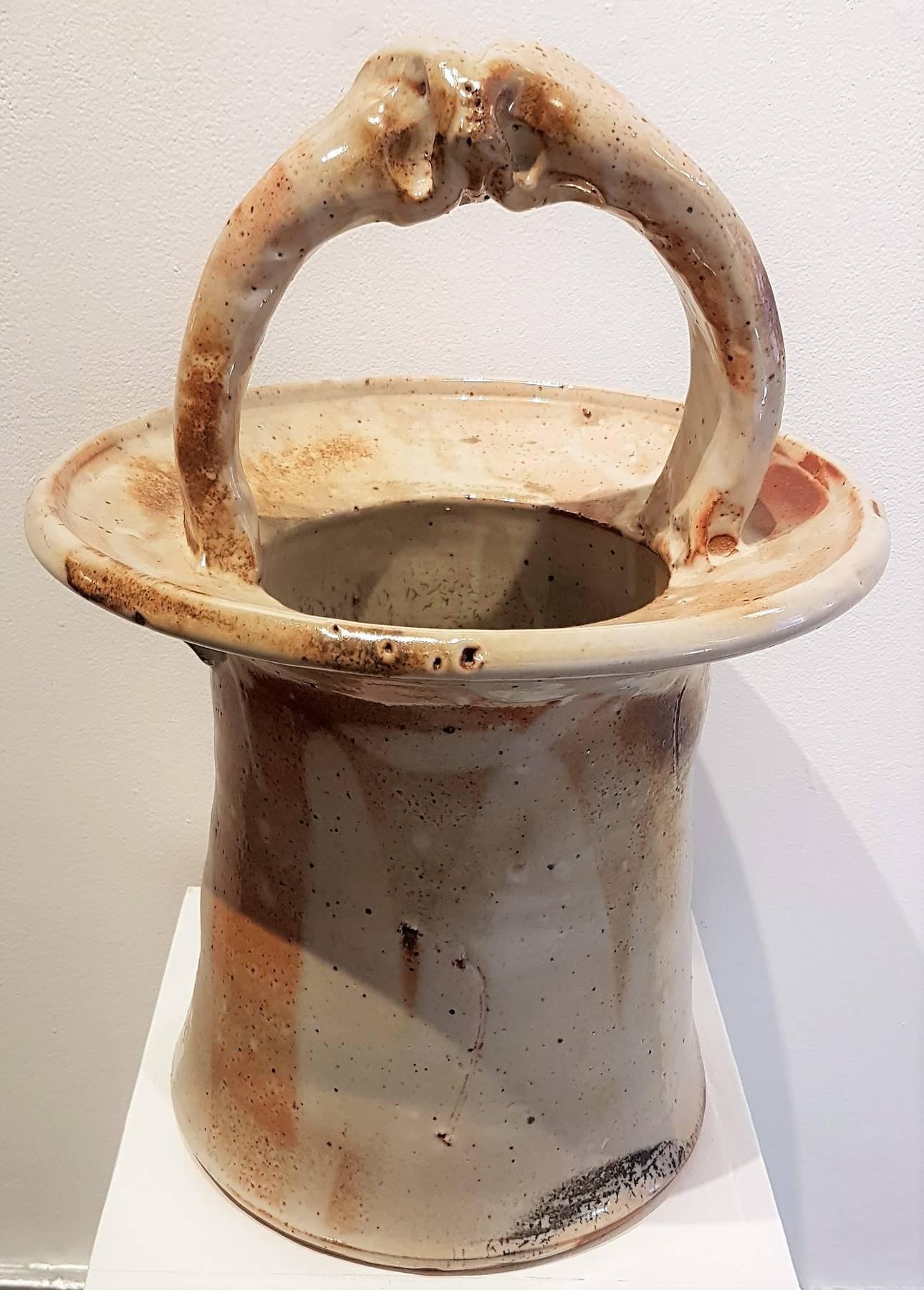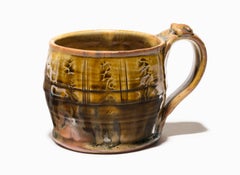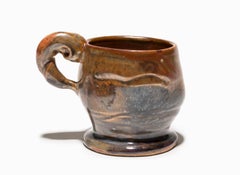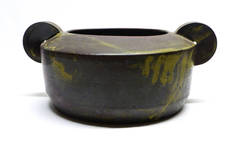
Sculptural Handled Bowl
View Similar Items
1 of 3
Richard FairbanksSculptural Handled Bowl
About the Item
- Creator:Richard Fairbanks (1929 - 1989, American)
- Dimensions:Height: 5.25 in (13.34 cm)Width: 12.5 in (31.75 cm)Depth: 9.75 in (24.77 cm)
- Medium:
- Movement & Style:
- Period:
- Condition:No damage to mention.
- Gallery Location:Renton, WA
- Reference Number:1stDibs: LU514534372
You May Also Like
- John Glick Plum Tree Pottery , Stoneware Mug, Deep Earth Tones, GlazedLocated in Detroit, MI“Untitled” ceramic, is an example of the kind of work by which John Glick became so famous. He was seduced by the effects of the reduction kiln, which decreased the levels of oxygen during firing, inducing the flame to pull oxygen out of the clay and glazes changing the colors of the glazes depending on their iron and copper content. In this way he achieved the rich gradients of ochre and umber and variations in stippling and opacity. This piece is signed on the bottom and can be found on page 129, plate #236 in “John Glick: A Legacy in Clay.” John was an American Abstract Expressionist ceramicist born in Detroit, MI. Though open to artistic experimentation, Glick was most influenced by the styles and aesthetics of Asian pottery—an inspiration that shows in his use of decorative patterns and glaze choices. He has said that he is attracted to simplicity, as well as complexity: my work continually reflects my re-examination that these two poles can coexist… or not, in a given series. Glick also took influences from master potters of Japan, notably Shoji Hamada and Kanjrio Kawai, blending their gestural embellishments of simple forms with attitudes of Abstract Expressionism. He was particularly drown to the work of Helen Frankenthaler whose soak-stain style resonated with Glick’s multi-layered glaze surfaces, which juxtaposed veils of atmospheric color with gestural marks and pattern. He spent countless hours developing and making his own tools in order to achieve previously unseen results in his work with clay and glaze. Glick’s “Plum Tree Pottery...Category
Late 20th Century American Modern More Art
MaterialsStoneware, Glaze
- John Glick Plum Street Pottery Reduction Fired Shino Glaze Cup Published in BookLocated in Detroit, MI“Untitled” ceramic, is an example of the kind of work by which John Glick became so famous. He was seduced by the effects of the reduction kiln, which decreased the levels of oxygen during firing, inducing the flame to pull oxygen out of the clay and glazes changing the colors of the glazes depending on their iron and copper content. In this way he achieved the rich gradients of ochre and umber and variations in stippling and opacity. This piece is signed on the bottom and can be found on page 92, plate #125 in “John Glick: A Legacy in Clay.” John was an American Abstract Expressionist ceramicist born in Detroit, MI. Though open to artistic experimentation, Glick was most influenced by the styles and aesthetics of Asian pottery—an inspiration that shows in his use of decorative patterns and glaze choices. He has said that he is attracted to simplicity, as well as complexity: my work continually reflects my re-examination that these two poles can coexist… or not, in a given series. Glick also took influences from master potters of Japan, notably Shoji Hamada and Kanjrio Kawai, blending their gestural embellishments of simple forms with attitudes of Abstract Expressionism. He was particularly drown to the work of Helen Frankenthaler whose soak-stain style resonated with Glick’s multi-layered glaze surfaces, which juxtaposed veils of atmospheric color with gestural marks and pattern. He spent countless hours developing and making his own tools in order to achieve previously unseen results in his work with clay and glaze. Glick’s “Plum Tree Pottery...Category
1990s American Modern More Art
MaterialsStoneware, Glaze
- Large Tea Bowl (brown glaze)By Peter VoulkosLocated in Kansas City, MOPeter Voulkos Large Tea Bowl (brown glaze) Stoneware and wood fired Circa mid-1990s 4.5 x 6 x 6 in Signed (bottom) COA provided Ref.: 924802-1004 Peter Voulkos (popular name of Panagiotis Voulkos; January 29, 1924 – February 16, 2002) was an American artist of Greek descent. He is known for his abstract expressionist ceramic sculptures, which crossed the traditional divide between ceramic crafts and fine art. While his early work was fired in electric and gas kilns, later in his career he primarily fired in the anagama kiln of Peter Callas, who had helped to introduce Japanese wood firing aesthetics in the United States. After serving in the United States Army during the Second World War, Voulkos studied painting and printmaking at Montana State College, in Bozeman (now Montana State University), where he was also introduced to ceramics; Frances Senska...Category
1990s Modern Sculptures
MaterialsStoneware, Glaze
$5,750 Sale Price41% Off - Large Tea Bowl (blue glaze)By Peter VoulkosLocated in Kansas City, MOPeter Voulkos Large Teabowl (blue glaze) Stoneware and wood fired Circa mid-1990s 4.25 x 6.5 x 5.5 in Signed (bottom) COA provided Ref.: 924802-1003 Peter Voulkos (popular name of Panagiotis Voulkos; January 29, 1924 – February 16, 2002) was an American artist of Greek descent. He is known for his abstract expressionist ceramic sculptures, which crossed the traditional divide between ceramic crafts and fine art. While his early work was fired in electric and gas kilns, later in his career he primarily fired in the anagama kiln of Peter Callas, who had helped to introduce Japanese wood firing aesthetics in the United States. After serving in the United States Army during the Second World War, Voulkos studied painting and printmaking at Montana State College, in Bozeman (now Montana State University), where he was also introduced to ceramics; Frances Senska...Category
1990s Modern Sculptures
MaterialsStoneware, Glaze
$5,750 Sale Price41% Off - Cup with Interior II (Hand-Painted, Gold Luster, Stereo, Couch, Flowers, Modern)By Melanie ShermanLocated in Kansas City, MOMelanie Sherman Cup with Interior II (Hand-Painted, Gold Luster, Stereo, Chair, Flowers) Porcelaneous Stoneware, Underglaze, Glaze, Porcelain Paint, Hand-made Vintage Decals, Gold Lu...Category
2010s Modern More Art
MaterialsLuster, Stoneware, Paint, Glaze, Underglaze
- Square vase "Couple" 2012. Stoneware, h 28.5 cmLocated in Riga, LVSquare vase "Couple" 2012. Stoneware, h 28.5 cm The Square Vase "Couple" is a striking ceramic vase that combines modern design with artistic elegance. Its square shape adds a contemporary touch, while the "Couple" motif adds a sense of intimacy and connection to the piece. Crafted from ceramic, a versatile and popular material in the realm of pottery and sculptural art, this vase showcases both aesthetic beauty and functional utility. The ceramic material allows for intricate details, smooth surfaces, and a range of glazes and finishes, enhancing its visual appeal. Inese Margevica (1960) Education: 2004 – LU, master's degree of educational sciences in art pedagogy; 2001 – LMA, Master of Arts degree; 1990 – LMA, Department of Applied Decorative Arts; 1981 – Riga Applied Arts Secondary School; 1977 – Riga 5th secondary school; Professional unions: 1992 – Artists' Union of Latvia; 1991 – ceramics association "Logs" Personal exhibitions: 2006 – "Black and white", in "Apsida" gallery, Riga; 2005 – "Touch", in the "Apsida" gallery in Riga; 2003 – "Black and white stories", in Satakunta Museum, Pori (Finland); 2003 – "Black and white stories", in the gallery "Apsīda" in Riga; 2000 – "Ceļabiedri", in the gallery "Apsīda" in Riga; 1998 – "Gaisma", Unibank branch in Riga; 1996 – "Feast over water", in the gallery "Jāņas sēta" in Riga; 1994 – "Ornamentalism and figuralism", in the gallery "Kolonna" in Riga; 1993 – "Chamots", in Reiterna House in Riga; Exhibitions: 2006 – Exhibition dedicated to the Assembly of the International Academy of Ceramics "Clay is everywhere" at the Museum of Decorative Arts and Design in Riga; 2006 – International mini-ceramics exhibition at the Riga Porcelain...Category
21st Century and Contemporary Modern More Art
MaterialsStoneware
